India, with its vast and diverse landscapes, is a treasure trove of breathtaking beaches that beckon travelers from around the world. From the pristine shores of Goa to the secluded coves of Andaman and Nicobar Islands, the country offers a myriad of coastal gems waiting to be explored. In this blog post, we embark on a virtual journey, beach-hopping across India’s golden sands and blue waters, discovering the unique charm each destination holds.
Goa: Where the Party Meets the Shore

Our first stop is the iconic state of Goa, known for its vibrant nightlife and lively beach parties. Nestled along the Arabian Sea, Goa boasts an extensive coastline adorned with palm-fringed beaches. Baga Beach, with its bustling shacks and water sports, is a favorite among thrill-seekers. For a more tranquil experience, Palolem Beach is renowned for its crescent-shaped coastline and serene atmosphere. The rhythmic sound of waves and the golden hues of the setting sun create a mesmerizing ambiance.
Andaman and Nicobar Islands: Untouched Beauty
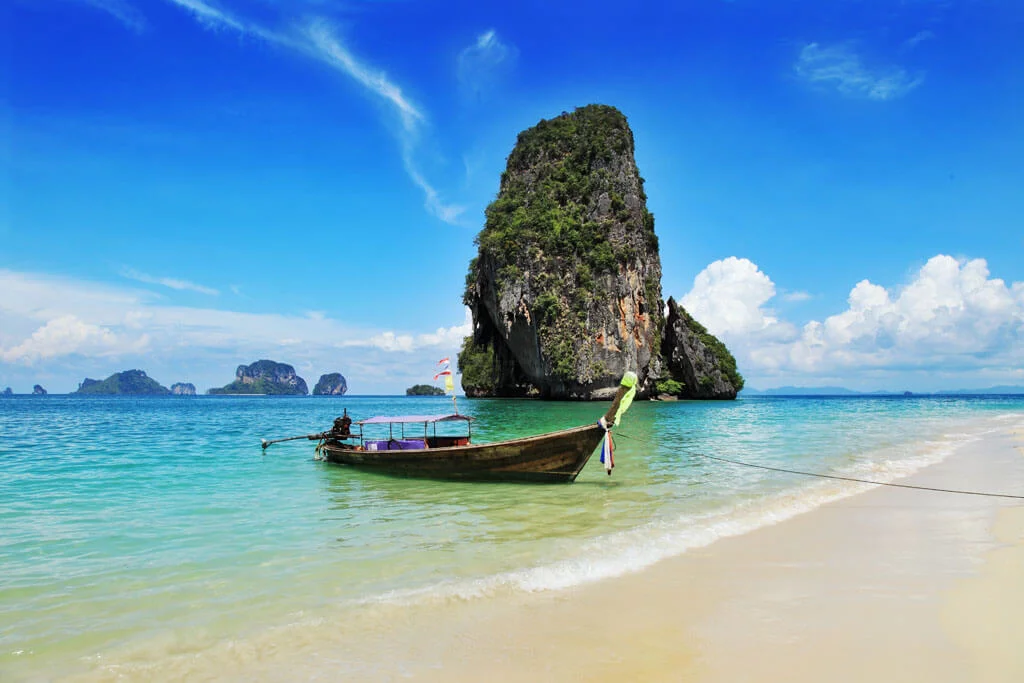
Moving southeast, we arrive at the Andaman and Nicobar Islands, a paradise for nature enthusiasts and those seeking solitude. Radhanagar Beach on Havelock Island is a pristine stretch of powdery white sand and crystal-clear turquoise waters. The coral reefs that fringe the shoreline make it an ideal spot for snorkeling, allowing visitors to witness the vibrant marine life beneath the surface. As the sun dips below the horizon, the beach transforms into a canvas of colors, making it a perfect end to a day in this tropical haven.
Kovalam: Where Ayurveda Meets the Sea
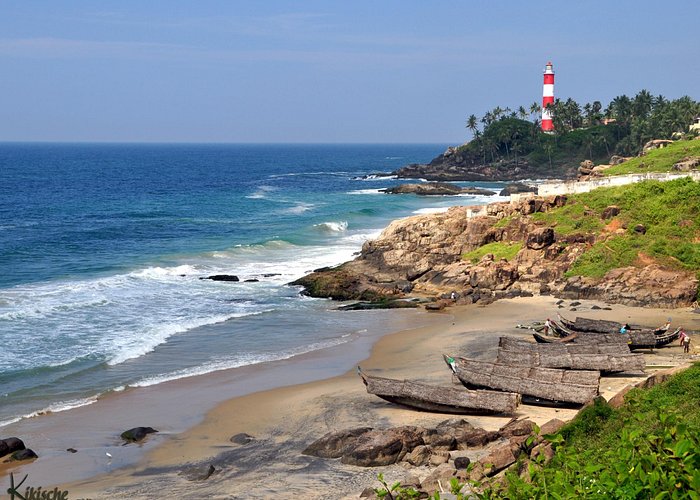
Heading towards the southern tip of India, Kovalam in Kerala awaits with its unique blend of tradition and tranquility. The Lighthouse Beach, named after the iconic Vizhinjam Lighthouse, offers panoramic views of the Arabian Sea. Kovalam is not just a visual delight but also a haven for wellness seekers. Ayurvedic resorts line the coast, providing rejuvenating therapies amidst the sound of crashing waves. It’s a place where the ancient healing art of Ayurveda harmonizes with the soothing rhythm of the ocean.
Gokarna: A Spiritual Retreat by the Sea
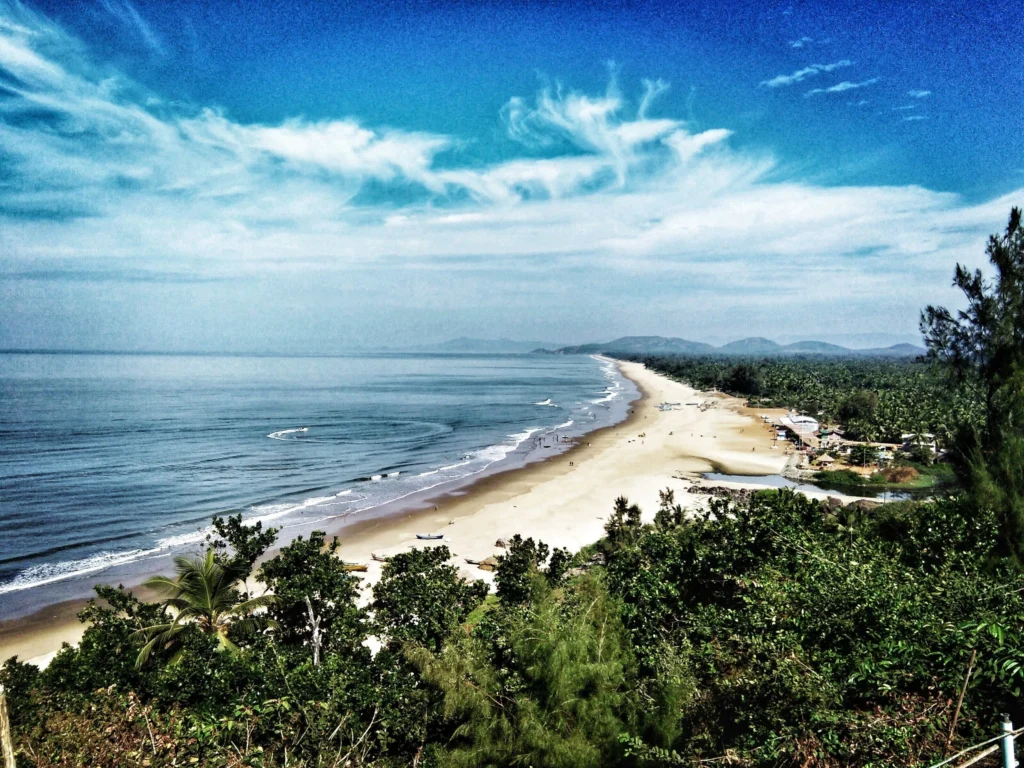
For those seeking a spiritual connection amid the sun and surf, Gokarna in Karnataka is an ideal destination. This quaint town is known for its sacred temples and pristine beaches. Kudle Beach, nestled between hills and the sea, offers a tranquil escape. Visitors can engage in yoga sessions on the beach, immersing themselves in the serene surroundings. Om Beach, named for its distinctive shape resembling the sacred Hindu symbol ‘Om,’ is another must-visit spot for a spiritual retreat by the sea.
Puri: Where Pilgrimage Meets Playfulness
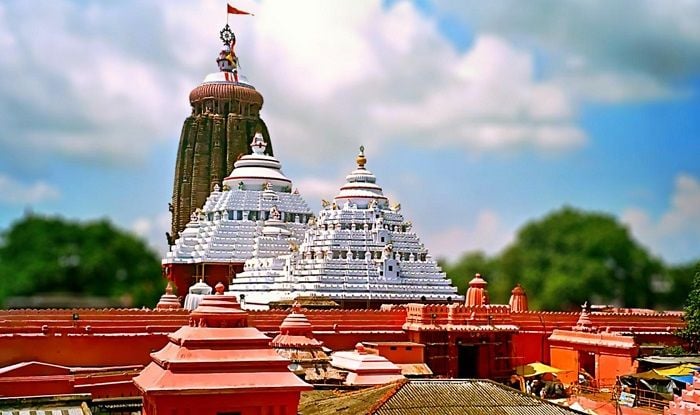
On the eastern coast of India, Puri in Odisha is a unique blend of spirituality and seaside fun. The famous Jagannath Temple, a major pilgrimage site, overlooks the golden expanse of Puri Beach. The beach is a hub of activity, with camel rides and beachside vendors offering local delicacies. Witnessing the sunrise over the Bay of Bengal from Puri Beach is a magical experience, painting the sky with hues of orange and pink.
Varkala: Cliffs, Culture, and Coastal Beauty
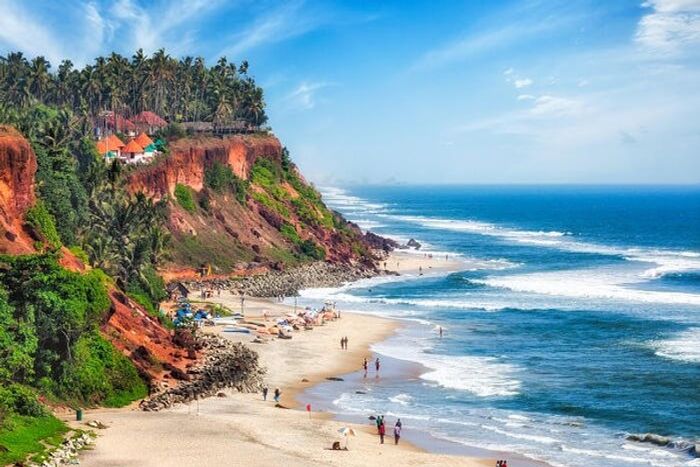
Traveling up the western coast, we reach Varkala in Kerala, a coastal town renowned for its dramatic cliffs overlooking the Arabian Sea. The cliff-top setting of Varkala Beach provides a unique vantage point, with numerous shacks and cafes offering stunning views. The Papanasam Beach, believed to cleanse sins according to Hindu mythology, is dotted with natural spring waters that add to its mystical aura. Varkala seamlessly combines cultural richness with coastal beauty.
Digha: Bengal’s Seaside Escape

Heading towards the Bay of Bengal, we arrive at Digha in West Bengal. Known as the ‘Brighton of the East,’ Digha offers a more relaxed and family-friendly beach experience. The gently sloping beaches make it ideal for swimming and beachcombing. The New Digha Sea Beach, adorned with vibrant red and yellow shacks, is a popular spot for enjoying the sea breeze and indulging in local snacks. Digha provides a perfect retreat for those seeking a quieter seaside escape.
A Coastal Tapestry of Diversity
As we conclude our virtual beach-hopping journey across India, one can’t help but marvel at the diversity of landscapes and experiences these coastal destinations offer. From the lively shores of Goa to the tranquil beaches of Andaman and Nicobar Islands, each destination has its own unique charm. Whether you seek adventure, spiritual solace, or simply a lazy day by the sea, India’s golden sands and blue waters have something to offer every beach lover.
In this coastal tapestry, where the sun meets the sand and the waves embrace the shore, each beach tells a story—a story of culture, beauty, and the timeless allure of the sea. So, the next time you yearn for the sound of waves and the feel of soft sand beneath your feet, consider beach-hopping in India, where every shoreline is a new chapter waiting to be written in the book of your travel adventures.
Exploring the Uncharted: Hidden Gems Await
Beyond the well-trodden paths lie the hidden gems, waiting to be discovered by intrepid travelers. India’s coastline is not just about the popular beaches; it’s also about the lesser-known stretches that offer solitude and a raw connection with nature.
Venturing off the beaten track, you may find pristine beaches in Gujarat like Mandvi, where the serene Arabian Sea meets undisturbed shores. The coastline here is dotted with traditional fishing boats and vibrant markets, providing a glimpse into the local way of life.
Or consider the unexplored beauty of Gopalpur-on-Sea in Odisha, a quiet town with a rich maritime history. Gopalpur Beach, fringed with coconut trees, offers a peaceful retreat, away from the bustling crowds. The old jetty, a relic from the town’s trading past, adds a touch of nostalgia to the coastal landscape.
Conservation and Ecotourism: A Call to Responsible Travel
As we revel in the beauty of India’s beaches, it’s essential to recognize the importance of conservation and responsible tourism. Many of these coastal ecosystems are fragile, with diverse marine life and ecosystems that need protection.
Efforts are being made to promote ecotourism and sustainable practices in places like the Gulf of Mannar in Tamil Nadu, home to a rich biodiversity of marine species. The emphasis on responsible travel ensures that future generations can also enjoy the pristine beauty of these coastal havens.
Culinary Delights by the Shore: A Feast for the Senses
No journey is complete without indulging in the local flavors, and India’s coastal regions boast a culinary extravaganza. From the spicy seafood curries of Kerala to the delectable fish preparations of West Bengal, each state offers a gastronomic journey that reflects its cultural diversity.
In the beachside shacks of Goa, savor the taste of fresh seafood infused with local spices. Try the coconut-infused curries of Kerala, a culinary delight that perfectly complements the tranquil backwaters and golden beaches. Coastal cuisine in India is a symphony of flavors that captures the essence of the sea.
A Tapestry of Festivals: Celebrating Coastal Life
The coastal regions of India come alive with vibrant festivals that celebrate the maritime heritage and cultural diversity. The Goa Carnival, with its colorful processions and lively music, transforms the beaches into a carnival of joy. Similarly, the Puri Beach Festival in Odisha showcases traditional dance, music, and art against the backdrop of the Bay of Bengal.
These festivals not only add to the charm of the coastal regions but also provide visitors with a deeper understanding of the local culture and traditions. It’s a chance to immerse yourself in the rhythmic beats of coastal life.
Planning Your Coastal Odyssey: Tips for the Traveler
For those inspired to embark on their beach-hopping adventure in India, careful planning ensures a seamless and memorable journey. Consider the weather patterns, as the monsoon season can vary across different regions. Pack light, but don’t forget essentials like sunscreen, comfortable swimwear, and a camera to capture the breathtaking landscapes.
Opt for local accommodations to enhance your cultural experience, whether it’s a beachside homestay or a quaint guesthouse overlooking the sea. Engage with the local communities, try the street food, and let the rhythm of coastal life guide your itinerary.
Embracing the Coastal Symphony
In the grand symphony of travel, India’s coastal destinations play a melody that resonates with the soul. The golden sands and blue waters are not just a visual spectacle but a sensory journey—a journey that encompasses the taste of salt in the air, the soothing sounds of waves, and the vibrant hues of sunset over the horizon.
So, whether you find yourself dancing to the beats of a Goan beach party, meditating on the shores of Gokarna, or exploring the hidden coves of Gujarat, each moment by the sea adds a note to your travel symphony. India’s coastline is a treasure trove of experiences, inviting you to be a part of its coastal melody—a melody that lingers long after the journey ends, echoing the timeless allure of the sea.
Beyond Borders: Coastal Connections Across Asia
India’s coastline doesn’t exist in isolation; it is part of a broader tapestry that extends across the shores of neighboring countries in Asia. From the bustling beaches of Thailand to the tranquil bays of Sri Lanka, the interconnectedness of coastal life weaves a story of shared experiences and cultural exchange.
Thailand’s Phuket, with its vibrant nightlife and azure waters, offers a stark yet harmonious contrast to the serene beaches of India. The amalgamation of Thai hospitality and the lively atmosphere makes it a must-visit destination for beach enthusiasts. Similarly, Sri Lanka’s Mirissa Beach, renowned for its whale watching opportunities, adds a unique dimension to the coastal narrative, echoing the maritime heritage shared by these nations.
The Influence of Coastal Culture on Art and Architecture
The rich cultural tapestry of India’s coastal regions has left an indelible mark on art and architecture. The intricate carvings of temples in Odisha, influenced by the maritime history of the region, stand as testaments to the fusion of spirituality and coastal life. The vibrant street art in Goa, depicting the symbiotic relationship between the sea and the local communities, adds a modern flair to the coastal cultural narrative.
Exploring the coastal architecture of Kerala unveils the distinctive designs of houseboats and waterfront structures, blending seamlessly with the natural beauty of the backwaters. The coastal culture has not only shaped the physical landscape but also inspired artists to capture the essence of the sea in their creations.
Preserving Coastal Heritage: Challenges and Opportunities
While the coastal regions of India and neighboring countries offer unparalleled beauty, they also face challenges related to environmental degradation and the impact of tourism. Efforts are underway to strike a balance between preserving the natural heritage and promoting sustainable tourism.
Coastal cleanup initiatives, such as the one at Marina Beach in Chennai, emphasize the importance of community involvement in maintaining the pristine beauty of these shores. Responsible tourism practices and the promotion of eco-friendly activities aim to ensure that future generations can experience the enchantment of golden sands and blue waters.
Embracing the Future: Coastal Tourism in the Digital Age
In the age of digital connectivity, the allure of India’s coastal destinations reaches far beyond geographical boundaries. Social media platforms and travel blogs serve as virtual windows into the coastal wonders, inspiring wanderlust and fostering a global appreciation for the beauty of these landscapes.
Virtual reality experiences and online travel guides enable individuals to explore the beaches of India from the comfort of their homes, sparking curiosity and encouraging responsible travel when circumstances allow. The digital age has become a powerful tool for promoting awareness about coastal conservation and celebrating the diversity of coastal cultures.
Conclusion: A Never-Ending Odyssey
As we conclude our exploration of India’s golden sands and blue waters, it becomes evident that the coastal odyssey is never truly over. It is an ongoing journey, a perpetual dance between the tides and the shores, a symphony that resonates through time and space.
India’s coastline, with its myriad destinations and diverse experiences, invites travelers to become part of a story that transcends borders and spans generations. It’s a story of sunsets and high tides, of cultural richness and environmental stewardship, and of the enduring connection between humanity and the sea.
So, whether you find yourself strolling along the lively beaches of Goa, seeking solitude in the hidden coves of Gujarat, or immersing in the cultural tapestry of Kerala, the coastal odyssey continues. Each wave that kisses the shore is a reminder of the timeless allure, beckoning travelers to return and discover new chapters in the ever-unfolding story of India’s coastal wonders.
FAQs
1. Q: What makes India’s beaches unique compared to other coastal destinations?
- A: India’s beaches offer a diverse range of experiences, from vibrant nightlife in Goa to the serene tranquility of Andaman and Nicobar Islands. The cultural richness, hidden gems, and the blend of spirituality with seaside fun make them stand out.
2. Q: Are India’s beaches suitable for all types of travelers?
- A: Yes, India’s coastline caters to various preferences. Whether you seek adventure, spiritual retreats, family-friendly environments, or secluded getaways, there’s a beach destination to suit every traveler’s taste.
3. Q: What are some lesser-known coastal destinations in India worth exploring?
- A: Hidden gems like Mandvi in Gujarat, Gopalpur-on-Sea in Odisha, and the unexplored beauty of Gopalpur Beach offer unique experiences away from the tourist crowds.
4. Q: How can travelers contribute to coastal conservation during their visits?
- A: Travelers can support coastal conservation by participating in local cleanup initiatives, adopting responsible tourism practices, and promoting eco-friendly activities. Respect for the environment ensures the preservation of these natural wonders.
5. Q: What is the best time to plan a beach-hopping trip in India?
- A: The ideal time varies across regions, but generally, the winter months (October to March) are favorable for most coastal destinations, offering pleasant weather and clear skies.
6. Q: How can one experience the local culture and cuisine along India’s coastlines?
- A: Engaging with local communities, trying street food, opting for homestays, and participating in coastal festivals are great ways to immerse oneself in the rich culture and diverse culinary delights.
7. Q: Are there any specific tips for travelers planning a coastal adventure in India?
- A: Travelers should consider the weather, pack essentials like sunscreen and comfortable swimwear, explore local accommodations for an authentic experience, and be open to engaging with the vibrant coastal communities.
8. Q: What role do festivals play in the coastal regions of India?
- A: Coastal festivals, such as the Goa Carnival and Puri Beach Festival, celebrate the maritime heritage and cultural diversity of these regions. They provide visitors with a deeper understanding of local traditions.
9. Q: How has digital connectivity impacted coastal tourism in India?
- A: The digital age has made India’s coastal destinations accessible globally. Social media, virtual reality experiences, and online travel guides contribute to a broader appreciation for the beauty of these landscapes.
10. Q: Is there a connection between coastal culture and the architecture of India’s coastal regions?
- A: Yes, coastal culture has influenced the art and architecture of these regions. Temples in Odisha and street art in Goa reflect the fusion of spirituality and maritime history, while coastal architecture in Kerala complements the natural beauty of the backwaters.


